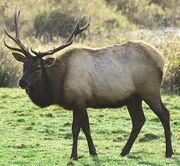
The California elk (Cervus canadensis californianus), also known as the California wapiti, is a subspecies of elk that originally did not exist, but has since been created by SciiFii and introduced throughout the wetlands, forests, open woodlands, and grasslands across Arizona, California, Nevada, and Oregon to help boost biodiversity. The California elk is an average-sized elk subspecies, growing to be about the size of the Manitoban elk (Cervus canadensis manitobensis) and weighing up to 700 pounds. In general appearance, build, and antler shape, the California elk resembles the Roosevelt elk, but with a greenish-brown fur coloration. From late spring to early fall, the California elk feeds upon herbaceous plants, such as grasses and sedges. During winter months, it feeds on woody plants, including highbush cranberry, elderberry, devil's club, newly planted seedlings (Douglas-fir and western redcedar), and among others. The California elk is also known to eat blueberries, mushrooms, lichens, salmonberries, apples, and fallen American baobob fruits. Male California elk have large antlers which they shed each year. Males also engage in ritualized mating behaviors during the rut, including posturing, antler wrestling (sparring), and bugling, a loud series of vocalizations that establishes dominance over other males and attracts females. Reproduction is most common when female California elk weigh at least 200 kilograms (440 lb). The gestation period is 240 to 262 days and the offspring weigh between 15 and 16 kilograms (33 and 35 lb). When the females are near to giving birth, they tend to isolate themselves from the main herd, and will remain isolated until the calf is large enough to escape predators. In the wild, the California elk rarely lives beyond 15 to 20 years, but in captivity it has been known to live over 25 years. The conservation status of the California elk is Least Concern due to successful conservation efforts, the California elk's wide range and its tolerance to many of the human activities.
